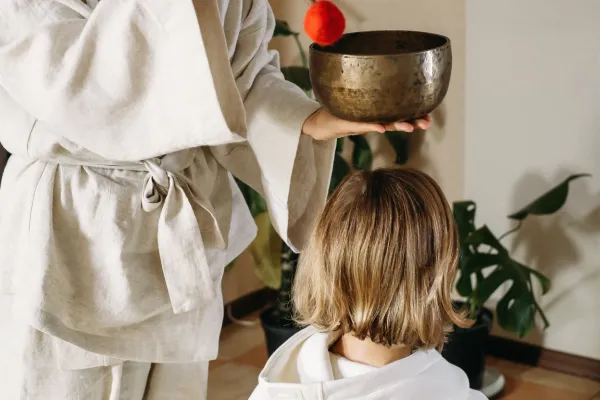
How Sound Healing Nurtures Emotional Development in Toddlers
How Sound Healing Nurtures Emotional Development in Toddlers
Being a mom to toddlers is no joke! You’re juggling diaper changes, snack negotiations, and those epic tantrums that pop up out of nowhere. It’s like a constant game of whack-a-mole, trying to keep everything under control while craving a moment of peace.
On top of that, you want to ensure your little ones grow emotionally and socially, but it can feel overwhelming to figure out how to support them through all the chaos.
Enter Sound Healing: This simple practice has been a game changer for in our home. If there’s one thing I’ve learned about toddlers, it’s that their emotions are BIG. When my kids are upset, instead of telling them to calm down, I hand them a drum or encourage them to hum loudly. It might seem silly, but giving them an outlet to express their feelings through sound has been incredibly effective. It helps them process their emotions in a healthy way, and I’ve noticed that they calm down faster after making noise.
The Power of Sound in Emotional Expression
Toddlers often struggle to articulate their feelings. They experience intense emotions that can be confusing, and sometimes words just don’t cut it. This is where sound healing shines. Engaging with musical instruments or simply creating sounds allows children to express their emotions uniquely. Whether they’re banging on a drum in frustration or softly strumming a guitar when calm, sound provides a healthy outlet for their feelings.
Finding Calm in the Chaos
Toddlers are bundles of energy, and that energy can lead to overwhelm. Certain sounds—like gentle melodies or low-frequency tones—have a calming effect on the nervous system. Encourage your kids to play with instruments like shakers or tambourines to channel that energy. Create a cozy sound circle with soft blankets and pillows, using instruments like singing bowls or chimes to explore how different sounds make them feel!
Mindfulness Through Sound
In our fast-paced world, teaching children to be present is crucial. Incorporating sound into daily routines promotes mindfulness in toddlers. Simple activities, such as participating in sound rituals with instruments, encourage children to focus on the moment. This practice enhances their ability to regulate emotions and fosters a deeper connection to their surroundings. We often have our kids play the singing bowls and soak in the vibrations, it’s a playful sound bath that has them mesmerized and leads to great sleep.
Sensory Play and Exploration
Sound is a vital component of sensory play, essential for young children’s development. When toddlers engage with sound instruments—like shakers, bells, or drums—they promote sensory exploration. This type of play supports cognitive growth and emotional understanding, as children learn to associate different sounds with feelings and experiences. It’s a joyful way for them to discover their world!
Building Connections Through Sound
Sound healing practices can strengthen the bond between caregivers and children. Shared experiences, such as making music together or participating in sound rituals, create a supportive environment for emotional growth. We use our Harmonium or shruti box and sing the Om sound or vocal tone an “AAHH” for deep relaxation.
Fostering Creativity and Imagination
Sound encourages creativity, allowing children to experiment and create their rhythms and melodies. This creative expression boosts self-esteem and helps them feel more confident in their emotional responses. When children explore their musicality, they learn to embrace their feelings and express them healthily.
Creating Routine and Security with Sound Healing
Integrating sound healing into daily routines provides children with structure and security. Familiar sounds serve as comforting cues to help them navigate their emotions.
1. Morning Jingle: Start the day with cheerful Koshi chimes or a fun song to set a positive tone.
2. Snack Time Serenade: Play a light, playful tune using maracas or hand drums during snack time for a mini dance party!
3. Calm Down Corner: Create a cozy spot with soft sounds from a singing bowl or ocean drum for when emotions run high.
4. Bedtime Lullaby: Use calming sounds from a tibetan bowl or soft music to signal it’s time to wind down.
5. Storytime Soundtrack: Enhance stories with soft background music or nature sounds using a rainstick or wind chimes for added magic.
As a mother, sound healer, and small business owner, I’m learning to embrace the chaos of parenting while nurturing my children’s emotional growth. Incorporating sound healing has transformed our home into a harmonious space for emotional expression.
Let’s be honest: no one has it all together, and I certainly don’t. I’m still figuring it out as I go, and some days feel like total chaos. But incorporating sound healing into our lives—into the small, everyday moments—has helped me create a sense of calm and connection that I never thought possible in the midst of parenting. It’s not perfect, and that’s okay. If you’re a busy parent, weave sound healing into your day with simple, heartfelt moments. Whether it’s a morning bell, a calming bedtime song, or letting your kids explore instruments like xylophones or bells, these small acts can make a big difference. Sound has the power to calm, heal, and bring us closer together, even on the craziest days! It doesn’t have to be grand or fancy—just real, raw, and a way to make life a little softer around the edges.
Remember, it’s not about doing it right; it’s about finding what works for you and your family, one sound, one breath at a time.
Hang in there, parents! We’re all in this together—let’s embrace the chaos and make some joyful noise!
